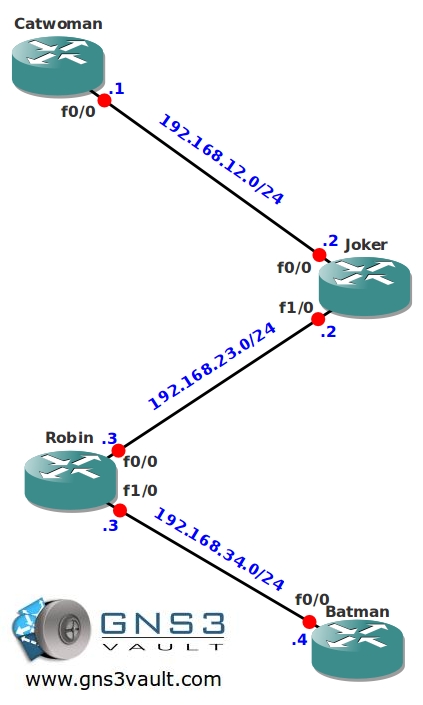Scenario
You are a network engineer and responsible for the main network of Gotham City. Multicast will be needed to send video replays throughout the city, and to decrease network load your boss has decided that you need to implement sparse-dense-mode. The network will be fairly large, so you don’t want to configure the RP address manually on every router, the network might contain non-Cisco router in the future so you’ll need to use a standards-based protocol.
Goal:
- All IP addresses on the physical interfaces have been preconfigured for you.
- Configure a loopback interface on router Joker:
Loopback0: 2.2.2.2/32 - Configure a loopback interface on router Robin:
Loopback0: 3.3.3.3/32 - Configure a loopback interface on router Batman:
Loopback0: 4.4.4.4/32 - Configure OSPF on all routers, advertise all networks. Achieve full connectivity.
- Configure sparse-dense-mode multicast on all routers.
- Configure Bootstrap so router Joker is the Rendezvous Point (RP), use the loopback0 interface.
- Configure router Batman to join the multicast group 224.4.4.4 on it’s loopback0 interface.
- Make sure you can ping the 224.4.4.4 group address from router Catwoman.
IOS:
c3640-jk9s-mz.124-16.bin
Topology:

Video Solution:
Configuration Files
You need to register to download the GNS3 topology file. (Registration is free!)Once you are logged in you will find the configuration files right here.

Do you want your CCNA or CCNP Certificate?
The How to Master series helps you to understand complex topics like spanning-tree, VLANs, trunks, OSPF, EIGRP, BGP and more.
Written by René Molenaar - CCIE #41726


Dear Rene,
I think their are a couple of changes required in this lab.
1. With BSR we dont need to configure Sparse-dense mode
2. You didnt mentioned which router should be the BSR aka Mapping agent…
Right on both counts. Pick an valid router for BSR (ensuring you don’t break RPF) and you should be OK.
Fun to lab!
show commands are very useful on this one.
show ip pim bsr
show ip mroute
etc..
Good luck to everyone studying for the CCIE R&S!